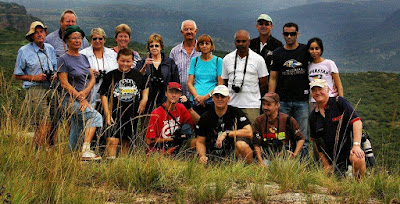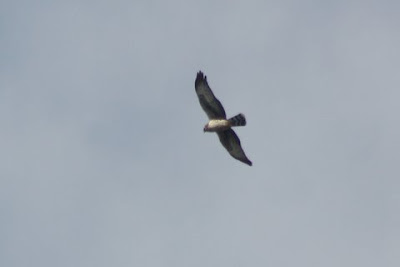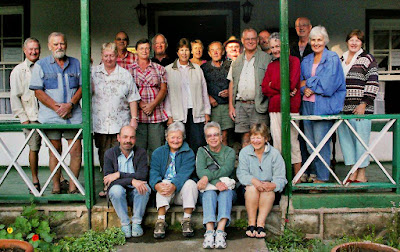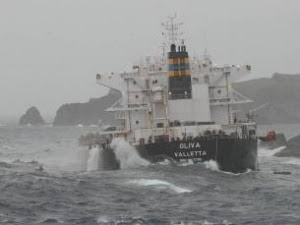Based on the South Coast of Kwazulu Natal, South Africa, our catchment area is between Scottburgh and Port Edward. Members are welcome from any part of the world. For more information see the 'About Us' or 'Contact Us' pages.
Monday 28 March 2011
Southern Grey-headed Sparrow expanding its range
''First, a reminder about the colour coding. In green quarter degree grid cells, the reporting rate in SABAP2 is greater than in SABAP1, and in orange it is the other way round, SABAP2 has smaller reporting rate than SABAP1. Blue means that the species has expanded into this quarter degree grid cell since SABAP1. Red means the species was recorded in SABAP1, but not (yet) in SABAP2. In pink quarter degree grid cells, the species was recorded in SABAP1, but there is no SABAP2 data yet. A dot means the species was not recorded in the quarter degree grid cell in either project. Yellow means that the reporting rates are identical for both SABAP1 and 2.
Secondly, this is not a definitive analysis. It is designed to show the general pattern, and suggest the species to be looked at more carefully.
But for the Southern Grey-headed Sparrow it does not require a statistical analysis to convince us that this is a species becoming more abundant – the overwhelming abundance of green is evidence for this. And it is clearly a species moving westwards, mainly into the Western Cape.
As SABAP2 coverage becomes more comprehensive, these range-change maps become more impressive and more useful.''
Source: SABAP2/ADU
Saturday 26 March 2011
Yellowwood Park Conservancy visit Simuma Conservancy
 |
| Representatives from NPC Cimpor Durban, Members of the Yellowwood Park Conservancy and Birdlife Trogons representatives at Mike Neethling's Vulture Restaurant, Oribi. (Photo Barry Porter) |
NPC Cimpor Simuma today hosted a visit by the Yellowwood Park Conservancy, Durban to it's Simuma Conservancy (formerly Oribi Conservancy). At the request of NPC Cimpor Simuma, Birdlife Trogons was represented by Barry Porter, Mike Fagan, John Marchant and Andy Ruffle.
The day started with a visit to Mike Neethlings vulture restaurant, where we were greeted by some 20 vultures busily devouring a carcass. Barry's earlier recky had revealed Jackals attending also, but these had unfortunately departed by the time we arrived.
Keeping our distance, we were able to obtain good views of the birds and the antics going on around the table.
| Cape Vultures attending a recently placed carcass at the vulture restaurant (Photo John Marchant) |
It wasn't long before the awkward attempts at launching into the air, signalled the birds awareness of our presence.
| Up, up and away. We've been spotted (Photo John Marchant) |
This allowed us to move closer to the cliff edge, where we had stunning views of the vultures perched on the cliffs and soaring in the valley below as they looked for thermals.
| Awaiting flight clearance (Photo John Marchant) |
|
Looking for thermals (Photos Andy Ruffle) |
Another bird of note to make an appearance, was a pair of Cape Rock Thrushes, one of which looked decidedly scraggy.
| Cape Rock Thrush near the vulture restaurant (Photo Andy Ruffle) |
The vulture restaurant had kept us occupied for longer than anticipated, so by the time the group moved on to the Simuma Conservancy, the heat of the day had set in, with the resulting lack of bird movement.
Yellow-eyed Canary could be heard singing in the trees and African Firefinch trilled amongst the grass, but both remained elusive to the eye. A short walk to other side of the river, over the newly repaired crossing, confirmed that our chances of seeing much birdlife had all but disappeared with the now searing heat of the sun. There was nothing more for it than to return to the Information Centre and partake in the splendid finger buffet laid on by NPC Cimpor Simuma, after which the visiting party gradually made there way back to Durban.
Tristan Islanders rally to save oiled penguins
 |
An oiled penguin is brought into the rehabilitation centre |
''Hundreds of oil-soaked rockhopper penguins have now been put into ‘rehab’ by Tristan Islanders facing a race against the clock to help save the endangered species''
But those assessing the impact of the disaster believe more than 10,000 birds could have been affected.
Local conservationists, volunteers and now experts from the Southern African Foundation for the Conservation of Coastal Birds and have been working tirelessly ever since to help the threatened birds.''
Read more....here
More updates and photos on the disaster can be found....here
Anyone wanting to donate money to help support the Tristan da Cunha community respond to the environmental disaster can join the UK-based Tristan da Cunha Association which exists to support the island http://www.tristandc.com/newsmsoliva.php
Photos: RSPB
Source: Birdlife international
Thursday 24 March 2011
Southport Swallow roost alive and well!!
by Andy Ruffle
Mike, John and I have just returned from the Southport swallow roost, where we were treated to a wonderful display of Barnies as they prepared for the night.
Swallows gradually started appearing in the vicinity of the roost around 1800 and had soon amassed into a swarm of literally thousands of birds, circling high over the area.
As the light faded the spectacle began. Wave after wave of birds spiralled into the reedbeds, each bird scrabbling for it's one little piece of space for the night. While all this was happening, a lone Spotted Eagle Owl could be seen hawking over the reeds.
What an amazing sight to round off the day.
And we thought it was all over! Well the fat lady hasn't sung yet obviously.
Mike, John and I have just returned from the Southport swallow roost, where we were treated to a wonderful display of Barnies as they prepared for the night.
Swallows gradually started appearing in the vicinity of the roost around 1800 and had soon amassed into a swarm of literally thousands of birds, circling high over the area.
As the light faded the spectacle began. Wave after wave of birds spiralled into the reedbeds, each bird scrabbling for it's one little piece of space for the night. While all this was happening, a lone Spotted Eagle Owl could be seen hawking over the reeds.
What an amazing sight to round off the day.
And we thought it was all over! Well the fat lady hasn't sung yet obviously.
And just for fun- A flying penguin!!
''Pete the penguin, who was travelling back home to San Diego's SeaWorld theme park, had been appearing at a show in San Francisco.
The on-board crew allowed him to stretch his legs during the 90-minute flight from San Francisco to San Diego, much to the amusement of his fellow – human – passengers.
Pete's SeaWorld keepers, who had taken the Arctic bird to a national science convention, took the opportunity to give people on the flight a free lecture on penguins.
South American Magellan penguins such as Pete are classified as a threatened species.
Videos of Pete the penguin uploaded by passengers on the flight began to appear on the web last week. ''
Source: Yahoo!
Wednesday 23 March 2011
New study reveals biofuels carbon con
 |
Jatropha plantation (RSPB) |
The report, commissioned by the RSPB (BirdLife in the UK), ActionAid and Nature Kenya (BirdLife Partner), focuses on the Dakatcha Woodlands in Kenya which are set to be destroyed to make way for jatropha plantations.''
''The area is also a global biodiversity hotspot and home to a number of globally threatened animal and bird species including the spectacular Fischer’s Turaco Tauraco fischeri, Southern Banded Snake-eagle Circaetus fasciolatus, Sokoke Scop-owl Otus ireneae, and Sokoke Pipit Anthus sokokensis. Clarke’s Weaver Ploceus golandi is found in only two places on earth and is threatened with extinction if the plantation goes ahead.''
read more.....here
Source: Birdlife International
Mini Mt Moreland in Sea Park
by Andy Ruffle
Over the past two evenings I've been treated to a wonderful display of hundreds of Barn Swallows swooping around my garden. They seem to be appearing around 1800 and gradually work their way towards the Southport area before disappearing again. I'm now wondering where they might be roosting, as they are hanging around too late to venture off to Umzumbe I'd say. I intend to check out the old Southport roost tonight and I'll post my findings.
Update- Well needless to say, all I saw this evening were two stray Barnies. The previous nights shows were possibly birds making their way north ready for the long journey back to their breeding grounds.
Over the past two evenings I've been treated to a wonderful display of hundreds of Barn Swallows swooping around my garden. They seem to be appearing around 1800 and gradually work their way towards the Southport area before disappearing again. I'm now wondering where they might be roosting, as they are hanging around too late to venture off to Umzumbe I'd say. I intend to check out the old Southport roost tonight and I'll post my findings.
Update- Well needless to say, all I saw this evening were two stray Barnies. The previous nights shows were possibly birds making their way north ready for the long journey back to their breeding grounds.
For an update on the real Mt Moreland Swallows see.....here
Tuesday 22 March 2011
Artist aims to raise a million Rand for Kamfers Dam flamingos
'On Wednesday 23rd March 2011, an exhibition of new works by Jeremy Houghton, inspired by the Near Threatened Lesser Flamingo Phoeniconaias minor will open at the Saatchi Gallery, London.
The exhibition will be raising funds in support of the Kamfers Dam wetlands, a conservation project centred on the largest Lesser Flamingo breeding population in South Africa. These wetlands contain a unique man-made breeding island, designed and created by Mark Anderson, Chief Executive Officer of BirdLife South Africa.'
read more.....here
Source Birdlife International
The exhibition will be raising funds in support of the Kamfers Dam wetlands, a conservation project centred on the largest Lesser Flamingo breeding population in South Africa. These wetlands contain a unique man-made breeding island, designed and created by Mark Anderson, Chief Executive Officer of BirdLife South Africa.'
read more.....here
Source Birdlife International
Monday 21 March 2011
Race to save oiled penguins after tanker strikes Tristan da Cunha
''A grounded cargo vessel has been wrecked on Nightingale Island – part of the Tristan da Cunha UK overseas territory in the South Atlantic – and an oil spill now threatens wildlife, including nearly half of the world population of Northern Rockhopper Penguin; classified as Endangered by BirdLife International on the IUCN Red List.
 |
| (Credit: copyright Trevor Glass) |
Hundreds of oiled penguins have already been seen coming ashore.''
Read more.....here
Source: Birdlife International
A lifeline to prevent Africa’s first recorded bird extinction
 |
Liben Lark (Photo Greg Davies) |
''Liben Lark with a population of possibly fewer than 100 birds, is widely tipped to become mainland Africa’s first recorded bird extinction, unless urgent action is taken to prevent its demise from the only area it now inhabits: a single grassy plain in southern Ethiopia.''
Mystery raptor at Rhodes **UPDATED 28th March
This photo was taken on the Naudes Nek drive while we were having breakfast. Those who were there, will remember having good sightings of Bearded Vulture. However, this bird is different and doesn't appear to be a juvenile Bearded Vulture (is it?) as was previously thought by some present.
Habitat is open hilly grassland at altitude.
So, thinking caps on please guys and let's see if we can crack this one.
Post your suggestions and reasoning under comments and let's see what we come up with.
(Tip: you can right click on the picture to save a copy to your computer. This will enable you to zoom in a bit if necessary)
28th March 2011- Well the id of our mystery bird has finally been solved.
A juv Black Harrier it is... see this interesting link here for confirmation.
 |
| (Photo Cathy Lee, Text Andy Ruffle) |
Habitat is open hilly grassland at altitude.
So, thinking caps on please guys and let's see if we can crack this one.
Post your suggestions and reasoning under comments and let's see what we come up with.
(Tip: you can right click on the picture to save a copy to your computer. This will enable you to zoom in a bit if necessary)
28th March 2011- Well the id of our mystery bird has finally been solved.
A juv Black Harrier it is... see this interesting link here for confirmation.
Saturday 19 March 2011
Oil spill threatens seabirds on Nightingale Island, southern Atlantic Island
SAFRING ringer, Claudia Holgate, is currently aboard the M/V Prince Albert II, a cruise ship to the Antarctic. She reports: "On Wednesday 16 March 04h30 the cargo ship Oliva ran aground on Nightingale Island close to Tristan da Cunha. Because our arrival in the area was within 24 hours, our ship was informed by local authorities and asked to assist. On Thursday afternoon we conducted a rescue operation with our zodiacs to get the 10 remaining crew off the vessel. At 02h30 on Friday morning (yesterday), the ship split in half." This picture of the stricken vessel was taken by Claudia Holgate.
Currently there is an oil slick spreading, and there are reports from Nightingale Island of Northern Rockhopper Penguins coming out of the sea covered in oil. Claudia reports: "The spill could not have happened at a worse place."
The Oliva was a 75 300 tonne cargo ship carrying soya beans from Brazil to Singapore, and was carrying about 1500 metric tons of heavy fuel oil. The ship ran aground at Spinners Point, the NW corner of the island. There are many species of birds that are only found in this area and a major oil leak may have catastrophic consequences to the bird life around these islands. Nightingale Island and the closeby Middle Island host breeding populations of seabirds numbered in millions. Another potential problem is rats finding their way from the sinking ship onto the island and this is a real threat to burrow nesting birds. A salvage tug, the Smit Amandla, was dispatched from Cape Town on 17 March, and is expected to arrive on 21 March. The distance from Cape Town is about 2000 km. On board the tug is Estelle van der Merwe, who was in charge of SANCCOB at the time of the Treasure oil spill, and she is working in close collaboration with SANCCOB.
Source http://www.adu.org.za/
Tuesday 15 March 2011
Rhodes Weekend Away 4th-7th March 2011 **UPDATED 31st March
| Just incase you're unsure of where you are. The Rhodes sign looms over the town. |
Monday 14 March 2011
Black-bellied Bustard
 |
| Mkhuze Game Reserve, September 2013
(Subsp notophila)
(Photo Stan Culley)
|
| Pretoriuskop, Kruger NP, November 2010
(Subsp notophila)
(Photo Andy Ruffle)
|
| Pretoriuskop, Kruger NP, November 2010
(Subsp notophila)
(Photo Andy Ruffle)
|
| Pretoriuskop, Kruger NP, November 2010
(Subsp notophila)
(Photo Andy Ruffle)
|
South Africa's bustards and korhaans are in trouble, with six of the country's ten species listed in "The Eskom Red Data Book for Birds of South Africa, Lesotho and Swaziland". "They are threatened by a variety of factors, including habitat destruction and collision with power-lines".
David Allan is the editor of the interesting and informative publication of Bustard Beat, which includes the following articles:
Ludwig's Bustard project update 2010 by Jessica Shaw
Update on the Southern Black Korhaan by Sally Hofmeyr
Kori Bustard conservation and ecology – saving one of the world's heaviest flying birds by Kabelo Senyatso
Does the Important Bird Areas programme adequately conserve South Africa's bustards and korhaans? by Ernst Retief
Conservation biology of the White-bellied Korhaan Eupodotis senegalensis Vieillot 1820 in South Africa by Craig Symes & Hanneline Smit
Twitching for conservation by Niall Perrins
The White-bellied Korhaan's identity crisis. Part 2 –`White-bellied' or`Barrow's'? by David Allan
Race is on to repopulate species of bustards by Vesela Toderova
Download can be found at http://www.birdlife.org.za/page/5561/bustard_working_group
or click onhttp://www.birdlife.co.za/data/files/bustard_beat_2_20110312142447.pdf
Tuesday 1 March 2011
Levaillant's Cisticola
Speckled Pigeon
Members gallery
2010
2011
2011
 |
| (standing from left) Doug Butcher, Ron Whitham, Val & Stan Culley, Cathy Lee, John Marchant, Margaret Jones, Elaine Whitham, Mike Fagan, Barry Porter, Pete Williamson, Herbie Osborne, Sandy Olver, Lennart Eriksson, Evelyn Heuinis, Jeanette Osborne, (seated) Andy Ruffle, Mary Mynors, Angie Butcher and Margie Williamson. (Photo Barry Porter, Lennart Eriksson and Pete Willaimson) From the post: Rhodes Weekend Away 4th-7th March 2011 |
Cape Rock Thrush
Great Spotted Cuckoo
Pied Kingfisher
Subscribe to:
Posts (Atom)



















